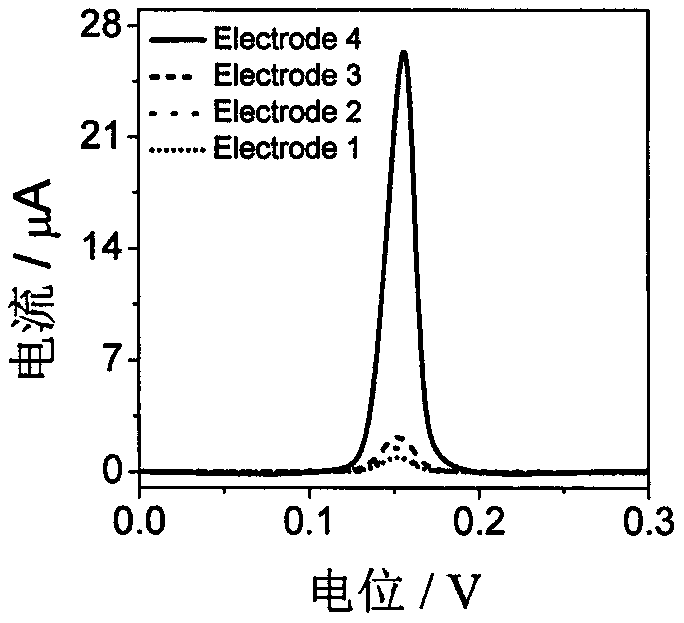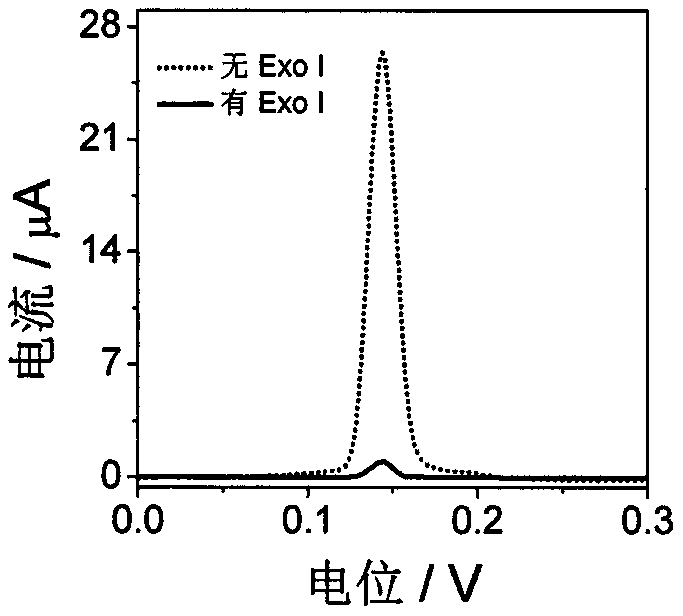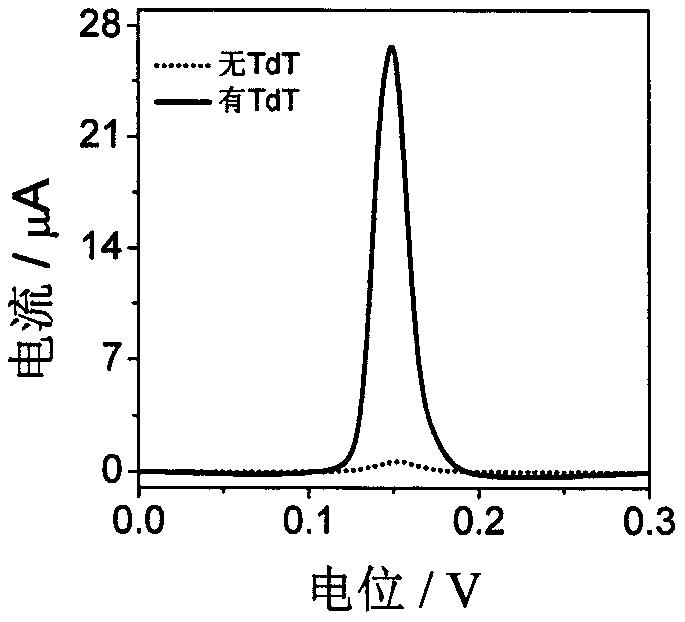Preparation method of electrochemical biosensor for simultaneously detecting Exo I and TdT and application thereof
A biosensor, electrochemical technology, applied in the field of functional biomaterials and biosensing, can solve the problems of inability to form AgNCs, affect the electrochemical signal output, signal drop, etc., and achieve good application prospects, fast detection speed, and easy operation. Effect
- Summary
- Abstract
- Description
- Claims
- Application Information
AI Technical Summary
Problems solved by technology
Method used
Image
Examples
Embodiment 1
[0038] Example 1 Preparation of sensor
[0039] (1) The specific preparation steps of the electrochemical biosensor are as follows:
[0040] Preparation of Electrode 1:
[0041] First, polish the gold electrode (diameter 2mm) on the suede with aluminum oxide powder for 5 minutes. After polishing, place the electrode in an ultrasonic cleaner and ultrasonically clean it with double distilled water for 5 minutes, and then use N 2 Blow dry and label Electrode 1.
[0042] Preparation of Electrode 2:
[0043] Take the sulfhydryl DNA solution (2.5μL, 10μM), drop it on the surface of Electrode 1, incubate overnight at 4℃, wash the electrode with distilled water buffer, treat with 1.0mM mercaptohexanol (MCH) for 30min, replace the surface of the electrode with non-Au-S Bond the immobilized sulfhydryl DNA, and wash the electrode slowly with distilled water, labeled Electrode 2.
[0044] Preparation of Electrode 3:
[0045] On the surface of Electrode 2 electrode, add 5.0μL TdT reaction solution (c...
Embodiment 2
[0049] Example 2 Feasibility experiment
[0050] In the preparation process of Electrode 3 in Example 1, before using TdT for extension, introduce Exo I solution (final concentration of 500U / mL), incubate at 37°C for 30 minutes for sensor preparation, and then prepare the sensor as in step (1). Used to detect the electrochemical response of ExoI. At the same time, the sensor prepared as in Example 1 was used to detect the electrochemical response of TdT.
[0051] Using square wave voltammetry, set the potential range from 0 to 0.3V and the amplitude to 25mV. The result is figure 2 , 3 Shown: when there is no Exo I, the electrochemical biosensor has an obvious response signal, and when Exo I is present, the electrochemical biosensor has almost no response signal in PBS (0.1M, pH 7.0) (such as figure 2 ). It is proved that the sensor can be used for Exo I activity detection. On the contrary, when there is TdT, the electrochemical biosensor has an obvious electrochemical response...
Embodiment 3
[0052] Example 3 Detection of Exo I activity at different concentrations
[0053] In the process of preparing Exo I electrochemical sensor, change the Exo I concentration (control the final concentration respectively: 0, 0.1, 0.2, 0.5, 0.8, 1, 2, 5, 10, 20, 50, 100, 200, 500, 800, 1000U / mL). The experimental results are as Figure 4 As shown, the linear range of the sensor's current response to the log value of Exo I concentration is 0.1~500U / mL, and the linear correlation equation is y=-7.12lgC Exo I +20.4, R 2 =0.9951, the detection limit is 0.05U / mL, indicating that the sensor can achieve highly sensitive detection of Exo I activity.
PUM
| Property | Measurement | Unit |
|---|---|---|
| Diameter | aaaaa | aaaaa |
Abstract
Description
Claims
Application Information
 Login to View More
Login to View More - R&D
- Intellectual Property
- Life Sciences
- Materials
- Tech Scout
- Unparalleled Data Quality
- Higher Quality Content
- 60% Fewer Hallucinations
Browse by: Latest US Patents, China's latest patents, Technical Efficacy Thesaurus, Application Domain, Technology Topic, Popular Technical Reports.
© 2025 PatSnap. All rights reserved.Legal|Privacy policy|Modern Slavery Act Transparency Statement|Sitemap|About US| Contact US: help@patsnap.com



